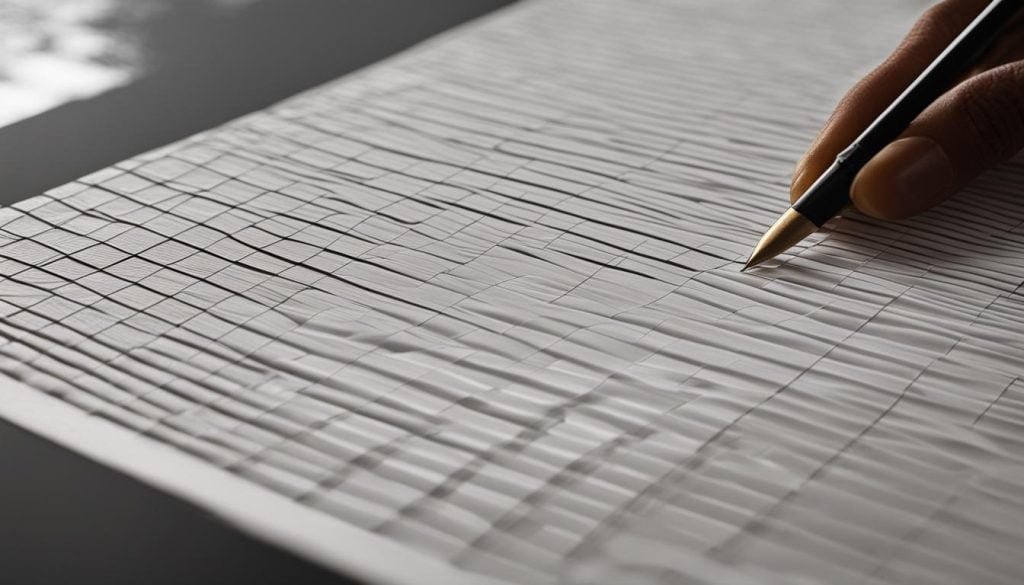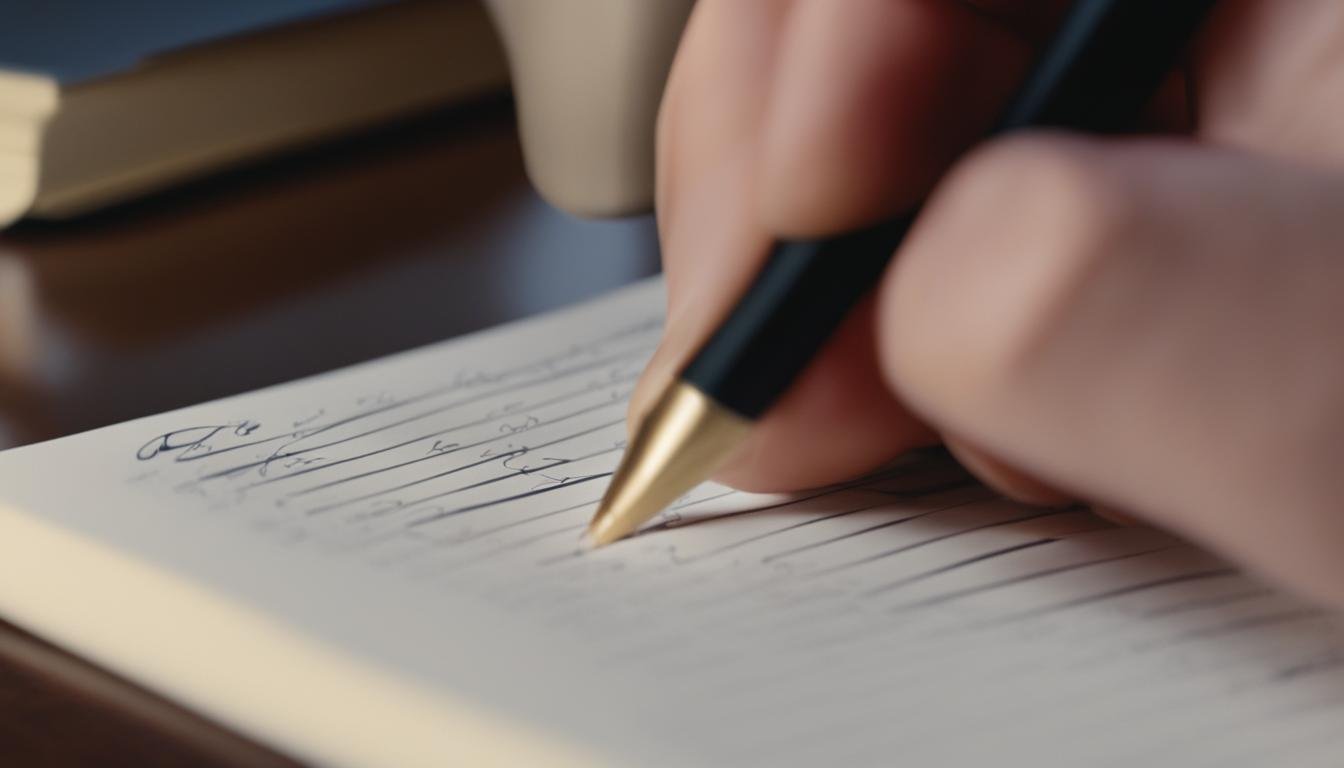Calligraphy Practice for Consistency: Discover the Secret to Continuous Improvement!
Calligraphy Practice for Consistency! Are you passionate about calligraphy? Do you aspire to create elegant and visually pleasing lettering? Consistency is the key! By focusing on practicing calligraphy for consistency, you can enhance the overall aesthetics of your work and take your skills to the next level.
In this article, we will explore the importance of consistency in calligraphy and provide you with practical tips to improve your stroke width, letter size, letter slant, and letter spacing. Whether you are a beginner or an experienced calligrapher, these insights will help you refine your craft and achieve stunning results.
Key Takeaways:
- Consistency in stroke width, letter size, letter slant, and letter spacing is essential for beautiful calligraphy.
- Practicing stroke uniformity exercises and controlling pressure can improve stroke thickness.
- Focusing on letter height and script proportions creates visually appealing lettering.
- A consistent slant throughout your letters adds a professional touch to your calligraphy.
- Regular spacing between words and paying attention to kerning enhances legibility and aesthetics.
Importance of Consistency in Stroke Width

When it comes to calligraphy, achieving consistency in stroke width is crucial for creating visually stunning lettering. The stroke width refers to the thickness and thinness of the pen strokes used to form each letter. By practicing stroke uniformity exercises, applying consistent pressure, and ensuring a uniform ink flow, you can improve the overall consistency of your stroke width.
One effective way to improve stroke width consistency is through stroke uniformity exercises. These exercises involve repeatedly practicing different strokes, focusing on keeping them consistent in thickness and thinness. By training your hand and eye coordination, you can develop a better sense of control and achieve more uniform strokes.
Furthermore, applying consistent pressure while writing is key to maintaining regular stroke width in calligraphy. This requires controlling the pressure applied to the pen or brush throughout each stroke. By practicing pressure control techniques, such as applying gentle pressure on downstrokes and releasing pressure on upstrokes, you can achieve more consistent stroke widths.
Another factor that contributes to stroke width consistency is ensuring a uniform ink flow. Inconsistent ink flow can result in uneven strokes and inconsistent thickness. To maintain a uniform ink flow, make sure to properly load your pen or brush with ink and periodically clean it to remove any dried ink or debris that may obstruct the flow. This will help you achieve more consistent and visually pleasing calligraphy strokes.
| Techniques for Consistent Stroke Width | Benefits |
|---|---|
| Practice stroke uniformity exercises | Improved control and uniformity in letter strokes |
| Apply consistent pressure | Regular stroke width throughout the lettering |
| Ensure uniform ink flow | Consistent thickness and thinness of strokes |
By focusing on stroke uniformity exercises, applying consistent pressure, and ensuring a uniform ink flow, you can enhance the overall consistency and visual appeal of your calligraphy strokes. Practice these techniques regularly to improve your stroke width consistency and elevate your calligraphy skills.
Achieving Consistency in Letter Size

Consistency in letter size is crucial when it comes to creating elegant calligraphy. By maintaining a regular letter height and balanced script proportions, you can achieve visually appealing and uniform lettering. One effective way to ensure consistent letter size is by using guide sheets during practice sessions. These sheets provide guidelines for the height and width of each letter, helping you develop muscle memory for consistent letter sizing.
Another technique to achieve consistent letter size is to pay attention to the proportion of each letter within a word and the overall script. Each letter should maintain a similar size in relation to the others, creating a harmonious composition. By practicing regularly and being mindful of letter size, you will gradually develop the ability to create calligraphy with consistent and balanced letter sizing.
Importance of Guide Sheets
Guide sheets are valuable tools for calligraphers, especially those who are just starting or want to improve their consistency in letter size. These sheets typically consist of horizontal and vertical lines that help you align and size your letters correctly. By placing your pen on these lines as you write, you can ensure that your letter height remains consistent throughout the piece.
Additionally, guide sheets can also include slant lines, which help you maintain a consistent letter slant. Using these lines as reference points, you can create calligraphy that flows smoothly and looks visually balanced.
| Benefits of Guide Sheets for Consistent Letter Size | How to Use Guide Sheets Effectively |
|---|---|
| 1. Improve muscle memory for consistent letter sizing. | 1. Print or draw guide sheets with appropriate line spacing and slant angle. |
| 2. Enhance overall consistency and aesthetics of calligraphy. | 2. Place guide sheets under your practice paper to provide visual reference. |
| 3. Develop a better understanding of letter proportions and spacing. | 3. Follow the guidelines provided by the guide sheet for letter height and width. |
| 4. Create calligraphy with balanced script proportions. | 4. Practice regularly with guide sheets to improve your consistency. |
Using guide sheets is a valuable technique to help you achieve consistent letter size in your calligraphy. By practicing with these sheets and focusing on maintaining balanced script proportions, you can create visually appealing and harmonious lettering. Remember to experiment with different styles and scripts to find the approach that works best for you. Practice regularly, and you will see significant improvement in your consistency and overall calligraphy skills.
Importance of Consistent Letter Slant

Consistency in letter slant plays a significant role in creating visually appealing calligraphy. Whether you choose a traditional or modern style, maintaining a consistent slant throughout your letters adds a professional and polished touch to your work. To achieve this consistency, the use of a calligraphy grid can be immensely helpful.
A calligraphy grid is a tool that consists of horizontal and vertical guidelines, which serve as reference points for maintaining a consistent letter slant. By placing your paper on the grid and aligning your strokes with the guidelines, you can ensure a regular and uniform slant in your lettering.
Additionally, practicing with guidelines can help you develop muscle memory for maintaining a consistent slant. Over time, your hand will become accustomed to the correct movement, resulting in more natural and effortless lettering. Remember to start with larger, exaggerated slants and gradually refine your technique as you gain confidence and proficiency.
Table: The Benefits of Using a Calligraphy Grid
| Benefits | Explanation |
|---|---|
| Consistent Slant | Helps maintain a regular and uniform slant in lettering. |
| Improved Accuracy | Assists in aligning strokes and keeping them parallel. |
| Enhanced Precision | Allows for more controlled and precise lettering. |
| Guided Practice | Aids in developing muscle memory for consistent slant. |
Using a calligraphy grid is like having a guiding hand as you create your letterforms. It gives you a sense of structure and stability, ensuring that your letter slant remains dependable and visually pleasing.
Incorporating the use of a calligraphy grid into your practice routine can significantly improve your letter slant consistency. By aligning your strokes with the guidelines and focusing on maintaining a regular slant, you’ll create harmonious and balanced calligraphy compositions.
Ensuring Consistent Letter Spacing

Proper letter spacing is crucial in creating visually appealing and legible calligraphy. Consistent letter spacing allows the words to flow seamlessly and ensures the overall harmony of your lettering. To achieve consistent letter spacing, there are several techniques and practices you can incorporate into your calligraphy journey.
Regular Spacing Between Words
One key aspect of consistent letter spacing is maintaining uniform spacing between words. When writing your calligraphy, pay attention to the space you leave between each word. Avoid overcrowding or leaving excessive gaps that may disrupt the flow and balance of your composition. By practicing regular spacing between words, you can create a visually pleasing rhythm and cohesion in your calligraphy.
Regular Kerning Practice
Kerning refers to the adjustment of space between individual letters. It plays a crucial role in achieving consistent letter spacing and helps create a balanced and visually appealing composition. Regular kerning practice involves assessing the spacing between each letter and making subtle adjustments to ensure uniformity. Experiment with different combinations of straight lines and curves to find the perfect balance for your calligraphy.
Remember, achieving consistent letter spacing takes time and practice. Dedicate yourself to regular practice sessions where you focus specifically on letter spacing. Embrace experimentation and explore different techniques to find what works best for you. By paying attention to these details, you’ll enhance the overall consistency and aesthetics of your calligraphy lettering.
| Technique | Description |
|---|---|
| Guideline Sheets | Using guideline sheets with evenly spaced lines can help you maintain consistent letter spacing. |
| Calligraphy Tools | Investing in high-quality calligraphy tools, such as pens with consistent ink flow, can contribute to achieving consistent letter spacing. |
| Visual Alignment | Visually aligning each letter can help you gauge the appropriate spacing and maintain consistency throughout your calligraphy. |
| Practice Sheets | Regularly practicing with dedicated calligraphy practice sheets can improve your muscle memory and help you achieve consistent letter spacing. |
In Summary, consistent letter spacing is crucial in creating visually appealing and legible calligraphy. By practicing regular spacing between words and regular kerning, you can achieve a balanced composition and enhance the overall consistency of your calligraphy lettering. Incorporate these techniques into your practice routine and embrace experimentation to find what works best for you.
Importance of Regular Practice for Consistency
Consistency in calligraphy can only be achieved through regular practice. By dedicating time every day to practice, you can improve your calligraphy skills and develop the consistency needed for elegant lettering. Two key elements to incorporate into your practice routine are repetitive practice sheets and calligraphy practice routines.
Repetitive practice sheets are designed to help you focus on specific stroke patterns and letter forms. By repeating these exercises regularly, you can develop muscle memory and improve your consistency in script weight. This muscle memory allows you to perform strokes and letterforms more effortlessly, resulting in smoother and more consistent calligraphy.
In addition to repetitive practice sheets, establishing a calligraphy practice routine is essential. By setting aside dedicated time each day or week for practice, you create a consistent habit that reinforces your skills. Whether it’s practicing individual letters, writing out quotes, or experimenting with different scripts, incorporating regular practice into your routine will significantly contribute to consistency in your calligraphy.
| Key Practices for Consistency in Calligraphy | Benefits |
|---|---|
| Repetitive practice sheets | Develops muscle memory for consistent stroke and letterform execution. |
| Calligraphy practice routines | Establishes a consistent habit of practice, reinforcing and improving calligraphy skills over time. |
Consistency in calligraphy also relies on developing calligraphy muscle memory. Through repetitive practice, your hand becomes accustomed to the motions required for each stroke and letter. This muscle memory enables you to achieve consistent script weight and maintain uniformity throughout your calligraphy.
With regular practice, you’ll not only see improvements in the technical aspects of calligraphy but also find a sense of rhythm and flow in your work. The more you practice, the more confident and comfortable you’ll become, allowing you to focus on achieving the desired aesthetic and consistency in your calligraphy.
Mastering Consistent Calligraphy Flourishes
Enhance your calligraphy skills by mastering the art of consistent flourishes. Adding decorative elements to your lettering can bring uniqueness and flair to your calligraphy compositions. With regular practice and attention to detail, you can achieve balanced and visually appealing flourishes that enhance the overall aesthetics of your work.
Consistency is key when it comes to calligraphy flourishes. Ensure that your flourishes follow a consistent style and stroke width throughout your piece. This will create a sense of harmony and cohesion in your calligraphy composition. Practice different basic and advanced flourish techniques to develop your skills and achieve the desired level of consistency.
When creating calligraphy flourishes, pay attention to their placement and balance within your composition. Incorporate flourishes in a way that complements the letters and enhances the overall layout. Aim for symmetry and harmony, while maintaining a consistent style and stroke width. This will ensure that your flourishes contribute to a visually stunning piece of calligraphy.
| Benefits of Consistent Flourishing | Techniques for Consistent Flourishing |
|---|---|
|
|
Remember, consistency in calligraphy flourishes comes with practice and patience. Take the time to master the techniques and strive for improvement with each stroke. Celebrate your progress along the way and enjoy the creative journey of mastering consistent calligraphy flourishes.
Creating Balanced Calligraphy Composition
When it comes to calligraphy, creating a balanced composition is essential for achieving visually appealing and harmonious lettering. By paying attention to various elements such as letter sizing, baseline adherence, spacing between words, and overall layout, you can ensure that your calligraphy composition is well-balanced and pleasing to the eye.
Consistent Letter Sizing
One of the key factors in creating a balanced calligraphy composition is maintaining consistent letter sizing. Ensuring that all letters have the same height and width can help create a sense of uniformity and harmony in your work. Using guide sheets or templates can be helpful in achieving consistent letter sizing.
Adhering to a Consistent Baseline
Another important aspect of a balanced calligraphy composition is adhering to a consistent baseline. The baseline serves as a guide for ensuring that all letters align properly and have a uniform appearance. By keeping your letters leveled along the baseline, you can create a sense of stability and cohesion in your composition.
Regular Spacing Between Words
Proper spacing between words is crucial for maintaining balance and readability in calligraphy. Ensuring regular spacing between words helps prevent overcrowding or gaps that can disrupt the overall flow of your composition. Paying attention to the spacing between words can greatly enhance the aesthetic appeal of your calligraphy.
Creating Balanced Calligraphy Layouts
Finally, creating a balanced calligraphy layout involves considering the overall arrangement of your lettering. Balancing the distribution of text and decorative elements can help create a visually pleasing and cohesive composition. Experiment with different layouts and placements to find the arrangement that best suits your calligraphy style.
Achieving balance in your calligraphy composition requires practice and attention to detail. By focusing on consistent letter sizing, adhering to a baseline, spacing words evenly, and creating balanced layouts, you can create visually appealing and harmonious calligraphy compositions that are sure to impress.
Developing Consistent Calligraphy Speed
When it comes to calligraphy, consistency is key, and this applies not only to stroke width, letter size, and spacing but also to the speed at which you write. Developing a consistent calligraphy speed will enhance the overall flow and uniformity of your lettering. By maintaining a steady pace and rhythm, you can achieve uniform strokes that create a visually pleasing effect.
One way to develop consistent calligraphy pacing is through regular practice. Set aside dedicated time each day to work on your calligraphy projects. Start by practicing slowly and deliberately, focusing on maintaining a steady speed. As you become more comfortable and confident, gradually increase your speed while still maintaining control over each stroke.
Consistency in calligraphy speed is particularly important when working on projects that require longer passages of text. By practicing regularly and applying a consistent speed, you’ll be able to achieve a smooth and seamless flow of your calligraphy, resulting in a more professional and polished end result.
| Benefits of Consistent Calligraphy Speed | How to Develop Consistent Calligraphy Speed |
|---|---|
|
|
In conclusion, developing a consistent calligraphy speed is crucial for achieving uniform and visually pleasing lettering. With regular practice and a focus on maintaining a steady pace, you can enhance the overall flow and consistency of your calligraphy. So, keep practicing and enjoy the process of refining your calligraphy skills!
Enhancing Consistency with Brush Pen Techniques
When it comes to calligraphy, using a brush pen can add a unique flair to your lettering. To enhance consistency in your brush pen calligraphy, there are a few techniques you can focus on. Let’s explore these techniques that will help you achieve uniformity and balance in your brush pen strokes.
Uniform Brush Pen Pressure
One of the keys to consistent brush pen calligraphy is maintaining uniform pressure throughout your strokes. By applying consistent pressure, you can achieve strokes with a consistent thickness. Practice controlling the pressure on your brush pen to create strokes that are visually appealing and well-balanced. This technique requires practice and attention to detail, but it can significantly improve the overall consistency of your brush pen calligraphy.
Steady Stroke Endings
Another important aspect of brush pen calligraphy is achieving steady stroke endings. Instead of tapering off abruptly, aim for a smooth and controlled ending to each stroke. This will create a cohesive and visually pleasing result. Paying attention to the way you lift your brush pen at the end of each stroke and practicing the motion will help you achieve consistent and elegant stroke endings.
Balanced Calligraphy Curves
Brush pen calligraphy often involves creating curved strokes and letterforms. To enhance consistency in these curves, practice maintaining a consistent angle and shape throughout. This will ensure that your curves have a balanced and harmonious appearance. Experiment with different brush pen sizes and pressures to achieve the desired effect. Consistency in your calligraphy curves will contribute to the overall flow and aesthetic of your brush pen lettering.
Consistency in brush pen calligraphy also relies on developing a regular pressure pattern. This means applying the same amount of pressure for strokes of the same thickness. Practicing with different brush pen sizes and experimenting with pressure control techniques will help you achieve a consistent pressure pattern. By maintaining regular brush pen pressure, you can achieve a cohesive and balanced look in your calligraphy.
Remember, mastering brush pen techniques takes time and practice. By focusing on uniform brush pen pressure, steady stroke endings, balanced calligraphy curves, and regular brush pen pressure, you can enhance the consistency and visual appeal of your brush pen calligraphy. Now that you have an understanding of these techniques, it’s time to put them into practice and watch your brush pen calligraphy flourish.
Tracking and Celebrating Progress
Tracking your calligraphy practice progress is an essential part of your journey towards improving your skills. By monitoring your progress over time, you’ll be able to see how far you’ve come and identify areas where you can continue to grow. Additionally, tracking your progress can provide you with the motivation and inspiration you need to keep practicing and pushing yourself.
One effective way to track your calligraphy practice is by keeping a calligraphy journal. In your journal, you can record the date, the exercises or techniques you practiced, and any observations or reflections you have about your practice session. This will not only help you keep a record of your progress but also allow you to look back and see how your skills have developed over time.
Celebrating milestones along your calligraphy journey is just as important as tracking your progress. When you achieve a new milestone, such as mastering a difficult flourish or completing a calligraphy project, take a moment to acknowledge and celebrate your accomplishment. This celebration can take various forms, such as treating yourself to a new calligraphy pen or simply giving yourself a pat on the back. By celebrating your milestones, you’ll reinforce your commitment to consistent practice and feel motivated to continue growing and improving.
Benefits of Tracking and Celebrating Progress:
- Keeps you motivated and inspired
- Allows you to see how far you’ve come
- Identifies areas for continued growth
- Helps you stay consistent in your practice
Remember, calligraphy is a journey, and progress takes time. Embrace every step along the way and enjoy the process of honing your skills. With consistent practice, tracking your progress, and celebrating your achievements, you’ll continue to grow as a calligrapher and create beautiful lettering that you can be proud of. Keep up the great work!
| Tracking and Celebrating Progress Tips: |
|---|
| ✅ Keep a calligraphy journal to record your practice sessions. |
| ✅ Set milestones for yourself and celebrate each achievement. |
| ✅ Reflect on your progress and areas for improvement regularly. |
| ✅ Join a calligraphy community to share and celebrate your progress with others. |
Conclusion – Calligraphy Practice for Consistency
Calligraphy practice for consistency is vital in achieving elegant and beautiful lettering. By focusing on stroke width, letter size, letter slant, and letter spacing, you can enhance the overall consistency of your calligraphy. Regular practice is key to honing your skills and developing muscle memory.
Remember to track your progress and celebrate milestones along the way. Keep a calligraphy journal or record your practice sessions to monitor improvement over time. Embrace the journey of mastering the art of consistent calligraphy lettering, and enjoy the satisfaction that comes with seeing your skills evolve.
Consistent calligraphy lettering is within your reach. Embrace the techniques and tips shared in this article, and through dedication and practice, you will see noticeable improvements in the aesthetics and quality of your calligraphy. So keep practicing, stay motivated, and let your creativity flow through consistent and beautiful lettering.
FAQ – Calligraphy Practice for Consistency
What is the most important aspect of practicing calligraphy?
Consistency is the most important aspect of practicing calligraphy. It involves maintaining consistency in stroke width, letter size, letter slant, and letter spacing.
How can I improve the consistency of stroke width in my calligraphy?
You can improve the consistency of stroke width in your calligraphy by practicing stroke uniformity exercises, applying consistent pressure, and ensuring uniform ink flow.
How can I achieve consistent letter size in my calligraphy?
To achieve consistent letter size in your calligraphy, focus on maintaining consistent letter height and balanced script proportions. Using guide sheets and practicing regularly can help develop muscle memory for consistent letter sizing.
Why is consistent letter slant important in calligraphy?
Consistent letter slant adds a professional and polished look to calligraphy. Using a calligraphy grid and practicing with guidelines can help you achieve a consistent and visually pleasing letter slant.
How can I ensure consistent letter spacing in my calligraphy?
To ensure consistent letter spacing in your calligraphy, practice consistent letter spacing, ensure regular spacing between words, and pay attention to kerning. Experimenting with different combinations of straight lines and curves can also help achieve consistent spacing.
How can I improve consistency in my calligraphy?
Consistency in calligraphy can only be achieved through regular practice. Using repetitive practice sheets, following calligraphy practice routines, and developing calligraphy muscle memory can help improve consistency in stroke, letter size, and script weight.
How can I add flair to my calligraphy?
You can add flair to your calligraphy by mastering consistent flourishes. Practice basic and advanced flourish techniques to achieve balanced and visually appealing decorative elements.
How can I create a balanced calligraphy composition?
Creating a balanced calligraphy composition involves paying attention to various elements. Ensure consistent letter sizing, maintain adherence to a consistent baseline, and carefully consider the spacing between words.
How can I develop consistent calligraphy speed?
Developing consistent calligraphy speed is essential for achieving uniform strokes and overall consistency. Practice maintaining a steady pace and rhythm in your lettering and gradually increase your speed as you become more comfortable and confident.
How can I enhance consistency with a brush pen?
If you prefer using a brush pen for calligraphy, you can enhance consistency by focusing on maintaining uniform brush pen pressure, ensuring steady stroke endings, and creating balanced calligraphy curves. Practice controlling the pressure on the brush pen to achieve consistent stroke thickness and overall consistency in your calligraphy.
How can I track my progress in calligraphy?
Tracking your calligraphy practice progress is important for recognizing improvement and staying motivated. Keep a calligraphy journal or record your practice sessions to monitor your progress over time.
Why is consistency important in calligraphy?
Consistency is key to achieving elegant and beautiful calligraphy. By focusing on stroke width, letter size, letter slant, and letter spacing, and practicing regularly, you can improve the overall consistency of your calligraphy lettering.




